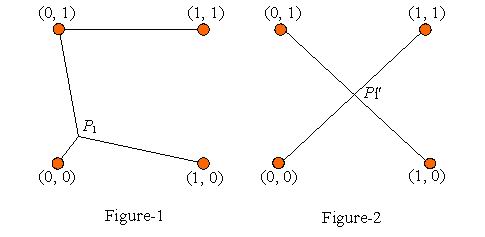当前你的浏览器版本过低,网站已在兼容模式下运行,兼容模式仅提供最小功能支持,网站样式可能显示不正常。
请尽快升级浏览器以体验网站在线编辑、在线运行等功能。
2053:Square
题目描述
Given a square at [0, 1] * [0, 1] that has N points ( P1, P2, ..., PN ) in the square (you may assume that different points can be at the same position), we can connect the N points and the four corners of the square with some line segments so that through these segments any two of the N+4 points can reach each other (directly or indirectly). The graph length is defined as the total length of the line segments. When N points' positions are fixed, there must exist a way of connecting them, such that it will make the shortest graph length. We can use LEN (P1, P2, ..., PN) to record the graph length using this way of connecting.
In this situation, LEN (P1, P2, ..., PN) is a function of P1, P2, ..., PN. When P1, P2, ..., PN change their positions, LEN (P1, P2, ..., PN) also changes. It's easy to prove that there exist some P1', P2', ..., PN' in the square such that LEN (P1', P2', ..., PN') is at its minimum.
Given the initial positions of N points, your task is to find out N points P1", P2", ..., PN" in the square such that |P1P1"| + |P2P2"| + ... + |PNPN"| is minimum and LEN (P1", P2", ..., PN") = LEN (P1', P2', ..., PN') . You are requested to output the value of |P1P1"| + |P2P2"| + ... + |PNPN"|, where |PiPi"| is the distance between Pi and Pi".

For example, Figure-1 gives the initial position of P1 and the way of connecting to obtain LEN (P1). In Figure-2, it gives the position of P1", which is at the center of the square, and the way of connecting to obtain LEN (P1"). It can be proved that LEN (P1") = LEN (P1’); your job is to output the distance between P1 and P1".
In this situation, LEN (P1, P2, ..., PN) is a function of P1, P2, ..., PN. When P1, P2, ..., PN change their positions, LEN (P1, P2, ..., PN) also changes. It's easy to prove that there exist some P1', P2', ..., PN' in the square such that LEN (P1', P2', ..., PN') is at its minimum.
Given the initial positions of N points, your task is to find out N points P1", P2", ..., PN" in the square such that |P1P1"| + |P2P2"| + ... + |PNPN"| is minimum and LEN (P1", P2", ..., PN") = LEN (P1', P2', ..., PN') . You are requested to output the value of |P1P1"| + |P2P2"| + ... + |PNPN"|, where |PiPi"| is the distance between Pi and Pi".

For example, Figure-1 gives the initial position of P1 and the way of connecting to obtain LEN (P1). In Figure-2, it gives the position of P1", which is at the center of the square, and the way of connecting to obtain LEN (P1"). It can be proved that LEN (P1") = LEN (P1’); your job is to output the distance between P1 and P1".
输入解释
The input consists of several test cases. For each test case, the first line consists of one integer N (1 <= N <= 100), the number of points, and N lines follow to give the coordinates for every point in the following format:
x y
Here, x and y are float numbers within the value [0, 1].
A test case of N = 0 indicates the end of input, and should not be processed.
x y
Here, x and y are float numbers within the value [0, 1].
A test case of N = 0 indicates the end of input, and should not be processed.
输出解释
For each test case, output the value of |P1P1"| + |P2P2"| + ... + |PNPN"|. The value should be rounded to three digits after the decimal point.
输入样例
1 0.2 0.5 2 0 0.5 0.5 0.5 0
输出样例
0.300 0.500
最后修改于 2020-10-29T06:21:54+00:00 由爬虫自动更新
共提交 0 次
通过率 --%
| 时间上限 | 内存上限 |
| 1000 | 30000 |
登陆或注册以提交代码